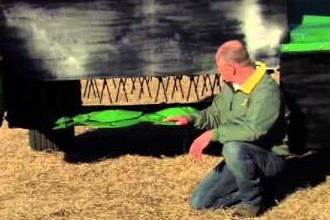Haymaking has been an integral part of the farming process for ages and fortunately the process has become easier with modern hay equipment. The power of hay equipment, combined with an intuitive and skilled farmer, provides the greatest likelihood of having a successful haymaking season.
In this post, we’ll highlight 11 John Deere videos from the series “Haymaking 101.” These videos will take you through the haymaking process from start to finish and the John Deere equipment that makes it possible. If you’re an experienced haymaker or completely new to the task, these videos are sure to provide insightful information for having a successful hay season.
1. Haymaking 101: #1
There is not a one-type fits all hay crop. Research which crop will be the easiest for your animals to digest and provide them with the most nutrients.
https://www.youtube.com/watch?v=V5WGYamz7L8&feature=share&list=PL7EE09975D75D44DC
2. Haymaking 101: #2
Your soil may need additional nutrients to be able to support your hay growth; the condition of the soil will determine your hay yields and weed presence.
https://www.youtube.com/watch?v=ilX8Sod0XgY&feature=share&list=PL7EE09975D75D44DC
3. Haymaking 101: #3
Determine when your field should be seeded and how to care for those seeds once they’re in the ground. John Deere recommends planting certified, clean, and weed-free seeds that will produce nutritious hay.
https://www.youtube.com/watch?v=njxuSBSVmOg&feature=share&list=PL7EE09975D75D44DC
4. Haymaking 101: #4
There are several harvesting machines that are designed for specific terrain, hay, and farmer needs. Choose the machine that will cut your crop to produce the highest quality hay and that leaves your field healthy for the next planting season.
https://www.youtube.com/watch?v=QH2ewn26JEw&feature=share&list=PL7EE09975D75D44DC
5. Haymaking 101: #5
Timing is everything in haymaking; every crop has its own signature sign for showing that it’s at the right time for harvesting. Farmers should also be checking the forecast to ensure enough dry weather to mow, rake, and bale your crop.
https://www.youtube.com/watch?v=3Rd-C_urlKw&feature=share&list=PL7EE09975D75D44DC
6. Haymaking 101: #6
Hay conditioner can be used to speed up the drying process so that you can bale sooner and move it off the field to an area protected from weather. There are several variables in how a hay crop dries; in order to determine the right conditioner for your crop, John Deere recommends referencing a chart in the haymaking handbook.
https://www.youtube.com/watch?v=aARzKm913Yc&feature=share&list=PL7EE09975D75D44DC
7. Haymaking 101: #7
Tools like a hay rake can help you scatter hay in the field so that every piece dries sufficiently. Once the hay crop has been raked into a windrow, it will be ready to bale once the moisture level is approximately 20%, which ensures top quality, nutrient-packed hay.
https://www.youtube.com/watch?v=vYUp1c1vunU&feature=share&list=PL7EE09975D75D44DC
8. Haymaking 101: #8
Determine what types of bales you will need: square or round. Round bales require a tractor that will make a tight bale with a solid core, and round balers have closely spaced teeth that will prevent leaf loss and preserve hay nutrients. Square balers are typically offset or directly behind the tractor.
https://www.youtube.com/watch?v=qsq8dS0hvsA&feature=share&list=PL7EE09975D75D44DC
9. Haymaking 101: #9
Round bales are too large to be stored indoors and, in order to keep them protected from the weather outside, you will need a tight bale wrap. Square bales are best stored in a well-ventilated barn or shed where rain can’t reach them.
https://www.youtube.com/watch?v=ZKtFMGmwrbs&feature=share&list=PL7EE09975D75D44DC
10. Haymaking 101: #10
Making hay as safely as possible will require you to compare the weight of the hay implement to the weight of your tractor; the tractor and implement should weigh the same. Check the load capacity before you overload a tractor and get into a troublesome situation.
https://www.youtube.com/watch?v=CgknncACFHs&feature=share&list=PL7EE09975D75D44DC
11. Haymaking 101: #11
Properly working equipment is essential when making hay. Ask your dealer how quickly service and maintenance can be done on your machine. Dealers are consistently trained in the newest haymaking techniques and information to ensure they can match equipment to your needs.
https://www.youtube.com/watch?v=twFmynjjkDs&feature=share&list=PL7EE09975D75D44DC
This haymaking season, be sure to brush up on your knowledge by researching the newest machines and baling practices. To view more instructional videos about John Deere hay equipment and haymaking best practices, visit the John Deere YouTube channel.
If you enjoyed this post, check out more videos and images on our Facebook page!


